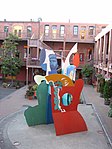University of Victoria Legacy Art Galleries
The University of Victoria Legacy Art Galleries (Legacy) is the university's art museum in Victoria, British Columbia, Canada, responsible for the accessibility and stewardship of an art collection which consists of approximately 18,000 objects including Canadian, Indigenous and international historic and contemporary art. Legacy activates the collection for research, teaching and learning for students, faculty and the general public through exhibitions, campus displays, publications, web-projects, public programs, and events—on site and through digital resources. Legacy has three main sites for rotating exhibitions including the Legacy Art Gallery at 630 Yates Street in Downtown Victoria, on campus at the Legacy Maltwood in the Mearns Centre for Learning - McPherson Library, and in the First Peoples House. Additionally, more than 2000 works from the collection are on display in buildings across campus and in the community, underlining the educational and community-building roles of art. The Legacy Downtown is also a site for public programs, and both university and community events.
Excerpt from the Wikipedia article University of Victoria Legacy Art Galleries (License: CC BY-SA 3.0, Authors).University of Victoria Legacy Art Galleries
Broad Street, Victoria Downtown
Geographical coordinates (GPS) Address Nearby Places Show on map
Geographical coordinates (GPS)
| Latitude | Longitude |
|---|---|
| N 48.426666666667 ° | E -123.36611111111 ° |
Address
Broad Street 1311
V8W 2A8 Victoria, Downtown
British Columbia, Canada
Open on Google Maps











